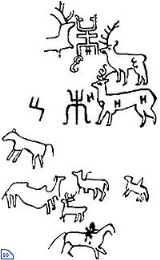
Ural characters
Encyclopedia

Ural (region)
Ural is a geographical region located around the Ural Mountains, between the East European and West Siberian plains. It extends approximately from north to south, from the Arctic Ocean to the bend of Ural River near Orsk city. The boundary between Europe and Asia runs along the eastern side of...
dated to 3,000—2,000 years BC and located along the coasts of Tagil River
Tagil River
Tagil is a river in Sverdlovsk Oblast, Russia. It is 414 km long, with a drainage basin of 10 100 km². The average discharge is 40 m³/s. The river has its sources on the eastern slopes of the Ural Mountains, east of Verkhny Tagil...
, Neyva River
Neyva River
The Neiva or Nevya is a 294-km-long river in the Sverdlovsk Oblast of Russia, which flows out of the picturesque Lake Tavatui along the slopes of the Ural Mountains through the towns of Nevyansk, Alapaevsk, and Novouralsk. The basin formed by the river has a total catchment area of 5,600 km². The...
, Rezh River
Rezh River
Rezh is a river in Sverdlovsk Oblast, Russia. It is a tributary of the Nitsa River . It is 219 km long, with a drainage basin of 4,350 km²....
, Yurozan River and some other sites. The color of the pictograms is different, varying from ochre
Ochre
Ochre is the term for both a golden-yellow or light yellow brown color and for a form of earth pigment which produces the color. The pigment can also be used to create a reddish tint known as "red ochre". The more rarely used terms "purple ochre" and "brown ochre" also exist for variant hues...
, probably mixed up with blood, to lilac and brown, while the thickness is between 10 and 20 mm. The existence of the Ural characters was known long ago. Peter the Great
Peter I of Russia
Peter the Great, Peter I or Pyotr Alexeyevich Romanov Dates indicated by the letters "O.S." are Old Style. All other dates in this article are New Style. ruled the Tsardom of Russia and later the Russian Empire from until his death, jointly ruling before 1696 with his half-brother, Ivan V...
in 1699 ordered the scrivener Yakov Losyov to go there and make an exact copy.
The Ural pictograms span for about 800 km from north to south. The northernmost ones were found on the rivers Kolva and Vishera, while the southernmost ones were detected at Belaya River. The majority of Ural pictograms, however, were discovered along the Tagil River.
Characteristics
The Ural pictograms are tied to indigenous Ural population, the Finno-Ugric peoplesFinno-Ugric peoples
The Finno-Ugric peoples are any of several peoples of Europe who speak languages of the proposed Finno-Ugric language family, such as the Finns, Estonians, Mordvins, and Hungarians...
. The pictograms were painted by finger or some tool from the ground level and artificial elevations, which allowed painting at the height of over three meters. Some pictogram lines are 4-5 cm thick. The images are generally aligned to south. The Ural pictograms include the images of birds, animals, humans and various geometrical figures. The images of animals mainly depict moose, deer and roe deer. The birds are generally represented by waterfowl
Waterfowl
Waterfowl are certain wildfowl of the order Anseriformes, especially members of the family Anatidae, which includes ducks, geese, and swans....
, mainly ducks and geese. Other images depict snakes and bear. Several pictograms of living beings feature skeleton pattern, showing the internal organs.
In 2001 a carved image was found at the River Rezh, which disproved the long-standing opinion that all Ural pictograms are painted.

